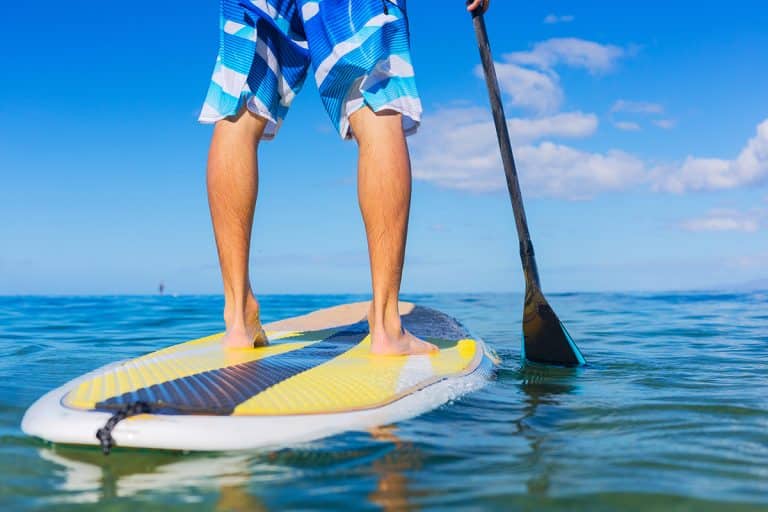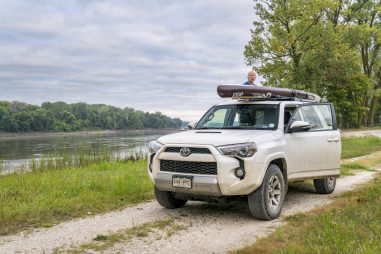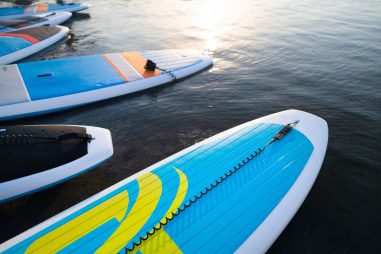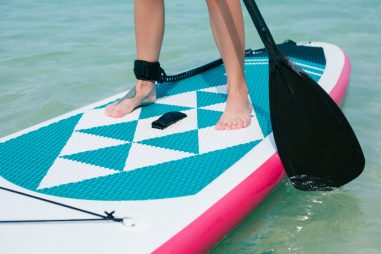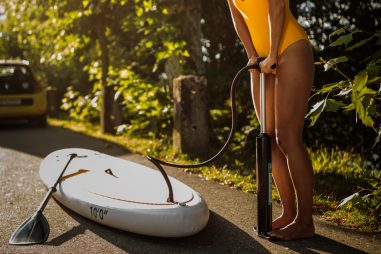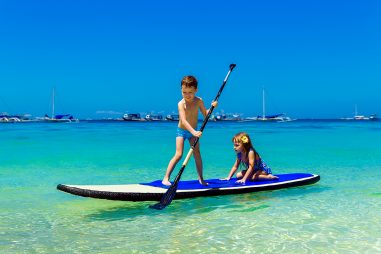Every stand up paddle boarding experience is unique because what you do on your stand up paddle board is entirely up to you. If you want to learn how to stand, balance, sit, or ride the wave using your stand up paddle board, then read on!
How Do You Get on a Stand Up Paddle Board?
The first step in enjoying stand up paddle boarding is learning the right way on how to get on the paddle board. Here is an easy step-by-step guide on how to do precisely that.
Step 1: Make sure to wear your leash.
Step 2: Lift the paddle board onto its side, standing up on the rail, and grab the paddle board by the center handle. Slowly make your way into the water.
Step 3: Once the water reaches your knees, you can safely set the board down on the surface of the water.
Step 4: Set your paddle across the board and slowly position your knees on either side of the center handle. Do this so your weight is distributed evenly.
If you are not comfortable sitting on your board, you can opt to ride it while lying down and paddling, like how surfers ride their boards before they catch a wave.
How Do You Start a Stand Up Paddle Board?
Once you are in the kneeling position, you can practice paddling using your hands. Do this until you are pretty comfortable on your board. You do not need to rush this part because you have to be comfortable on your board before you even try standing up.
If you think you are now ready for the next step, hold the paddle and position it across the board in front of you. Then, slowly and one at a time, put your feet where your knees had been sitting. Try to stand up slowly, plant your heels flat on the board, look forward, and start paddling.
How Do You Balance a Stand Up Paddle Board?
Beginners who are not yet accustomed to stand up paddle boarding may be wobbly on the board at first, but there is no need to worry because there are many ways to perfect your balance.
Understandably, you would struggle with your balance first, but you must keep your feet parallel to each other and at least hip-width apart. You should also remain standing with your knees slightly bent, your toes facing forward, your back straight, your chest forward, and focus your eyes on something stable like a mountain or the horizon.
Another tip is that once you stand upright on your board, you must immediately paddle. Paddling will help you remain steadier on the board, and it will help you build that momentum. It is also great if you can keep your paddle in the water as much as possible, as this adds more stability.
You must also remember to relax your feet. While it is natural to grip the board with your feet if you are feeling a little wobbly, doing so could lead to your feet being numb or tired. Keep your feet relaxed by wiggling your toes and rocking your heels from time to time. If standing makes you tired, you can always rest by sitting down on your board.
Remember never to lean forward or look down on the water for too long because this will make it harder for you to find your balance.
How Do You Catch a Wave on a Stand Up Paddle Board?
If you are now comfortable riding your stand up paddle board, maybe it is time to take on a new challenge and learn how to catch waves with your board. However, catching a wave may not always be possible because you would have to be in the right spot and on the right day.
So how do you pick the right day? You must remember that waves for stand up paddle boarding are different from those waves that you ride when you are surfing. Waves that are appropriate for stand up paddle boarding are often knee to shoulder in height and those that break slowly. You must remember to avoid watching waves that break quickly, especially in shallow water.
Aside from the condition of the wave, your perfect day should not be too windy. Too much wind can hinder you from seeing the waves. Aside from that, too much wind can also reduce the quality of the waves.
Now, onto picking the right spot. You must pick a location with great waves but are less populated by surfers, swimmers, or other stand up paddlers. If you are a beginner, you must remember to stay away from clear peaks, especially if there are surfers around. You need plenty of room to catch a wave perfectly, and you cannot do that it if there are other people in your immediate vicinity.
Now that you know what day and spot to pick, how do you actually catch a wave with your stand up paddle board? Here are what you should do to ride those waves like a pro.
- Approach your wave: You have to wade out until you reach chest-deep water while lying on your board. Make sure to tuck your paddle under your chest while you paddle. Once you see an approaching wave that you can catch, slowly lift your body up onto your arms while making sure that the paddle remains steady on the surface of your board.
- Choose your wave: Lucky for you, waves come in sets, so you can have a variety of waves to choose from. You have to patiently wait for the right wave because, ultimately, catching one is a matter of timing. You must always catch a wave before it breaks, and remember to never go to it too early because the wave will not pick you up.
- Catch your wave: Once you have chosen your wave, it is now time to catch it. To help keep your balance, you must paddle closer to the wave at a 90-degree angle with a staggered stance. In doing a staggered stance, which is halfway between a parallel stance on a paddle board and a full surf stance, you must place one foot in the middle of the board and the other foot slightly off towards the back. You must continue paddling hard towards the beach using whatever paddling technique that you are comfortable in. Paddling will help you to travel at the same speed as the wave when you catch it, and without this speed catching the wave will be impossible. You should also remember to maintain your knees in a bent position, and you must ensure that your weight is on the front of the board. Once you have caught the wave, you should change your position into a full surf stance.
How Do You Stand Up Paddle Board in the Ocean?
Stand up paddle boarding in the ocean can be a lot more difficult than, say, paddle boarding in a lake, or a bay, or a reservoir, or somewhere where there is no current. Paddle boarding in the ocean is a whole new ball game because you would have to face the currents, massive waves, and the ever-changing wind conditions. But lucky for you, we have the tips to keep you rolling on your board out in the big, mighty ocean.
- Wear your leash and personal flotation device: No matter what sport you are doing, the first tip is safety first. Never, ever enter the water without attaching your leash and wearing your personal flotation device or PFD. The current and the big waves can easily knock you off of your board. The leash will ensure that you can get ahold of your board and that the wind will not pull it, and the PFD will ensure that you will be floating on the water.
- Scan the entry points and the overall safety of the location: Is the water a little too crowded today? Maybe it is not the best time to go stand up paddle boarding in the ocean. You must also pick the best spot in which you can safely enter the water. Remember always to avoid areas with too many swimmers, surfers, or fellow stand up paddlers so you can lessen the chance to get hurt or inflict injury on other people.
- Entering the water: You must remember never to enter the water while holding the board parallel to the coast because doing so may lead to a wave catching the belly of the board and flipping you over. Instead, choose to hold the board under your arm just until you water that reaches your waist.
- Paddling in the ocean: Once you are successfully in the water, you can place the board with the nose facing forward next to you. Grip your paddle and place it securely in a lengthwise position on the board. Allow the board to ride over the break as you dive into the wave as you walk across it. When there’s a break in the waves, run as hard as you can to get deeper into the water and well past the break. Another technique you can do is tuck the paddle under your body while you lie down on the board and paddle with your hands like you would on a regular surfboard. You can do this, especially if the tide is higher and the waves are breaking further out.
How Do You Use an Inflatable Stand Up Paddle Board?
There are a lot of pros in buying and owning an inflatable stand up paddle board as opposed to purchasing a traditional hardboard. Inflatable stand up paddle boards are lightweight, more compact, very portable, highly durable, and overall a lot more convenient than their hardboard counterparts.
But how do you use an inflatable stand up paddle board?
- Setting up: Every inflatable paddle board comes with a high-pressure pump that will inflate your board. You can start off by assembling the pump. To do this, connect the non-nozzle end of the hose to the pump and attach it securely. Before you start pumping your stand up paddle board, make sure that the yellow pin in the valve of the inflatable stand up paddle board is up to prevent the air from escaping once you are done pumping. Next, attach the hose of the pump to the valve by pushing it down and twisting it clockwise. You can now start pumping air into your paddle board.
- Carrying into the ocean: You can carry your inflatable stand up paddle board the same way as you would a hardboard. Lift one side until it is standing on a rail and carry the board using the center handle. Remember to place the board down on the surface of water once you reach knee-deep water.
- Standing on an inflatable stand up paddle board: Getting up and standing on an inflatable stand up paddle board is the same as when you would mount and ride a hardboard one. You must first get on the board on your knees kneeling down, and once you are comfortable, you can try to plant your feet where your knees had been, slowly. You should keep your feet hip-width apart with your toes facing forward, your back straight, and your gaze forward.
- Cleaning and maintenance: You do not need any fancy cleaning material to clean your inflatable stand up paddle board. Often, clean water would be enough, but if you need extra cleaning, then you can simply use mild soap. Rinse your board well and make sure that it is completely dry.
- Storing your board: If you are storing your board while inflated, make sure that it is completely clean and dry before storing it in a cool, dry place. If you plan to store it for a lot longer, choose a storage with insulation. You can also deflate the board before storing it by removing the fins and the leash first and pushing the yellow valve pin to let the air out completely.
Can You Sit Down on a Stand Up Paddle Board?
The SUP may have been designed for standing, but you can most definitely sit on it in many different positions. You can paddle while kneeling, or you can sit cross-legged on your board when it is stationary. Heck, you can even lie down on your board!
While the primary purpose of stand up paddle boards is to experience riding above the water while standing up, you can do a lot more than just that. There are no strict rules on how to use your stand up, paddle board. One of the many reasons why stand up paddle boarding is so unique is because what you do on your paddle board is entirely up to you.

